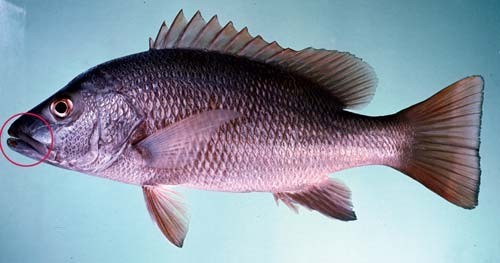Queensland - 70 native fish species benefit from fishways installation
by Dept Fisheries Queensland on 14 Apr 2009

Adult mangrove jack
(Photo: JE Randall) Department of Fisheries Queensland
http://www.dpi.qld.gov.au
Barramundi, mangrove jack and mullet are among the 70 native fish species that have benefited from the construction of 20 fishways on Central and North Queensland streams and wetlands in the past 12 months.
Minister for Primary Industries, Fisheries and Rural and Regional Queensland Tim Mulherin said the fishways have opened up hundreds of kilometres of fish habitat previously blocked by man-made barriers.
The Minister congratulated Mackay-based senior fisheries biologist Tim Marsden who heads the Northern Fish Community and Fishway Monitoring team
The most recent 20 fishways built or facilitated by the team include:
Mackay Whitsundays Region (funded by Reef Catchments NRM)
Flaggy Rock Creek, Marion Creek, Denman creek, Neilson Creek, Constant Creek, Tedlands Wetlands, St Lawrence Wetlands, O'Connell River (Staffords crossing), O'Connell River (Porters Road), O'Connell River (Ellis Road), Seaforth Creek, Lethebrook Creek, and Gregory River (Proserpine)
Burdekin Catchment (funded by NQ Dry Tropics NRM)
Bogie River, Kirknie Creek, The Ananbranch (Burdekin River), and Horseshoe Lagoon.
Nicholson Catchment in the Gulf (funded by Southern Gulf Catchments NRM)
Escott Causeway, Gin Arm Creek, and Gregory River (Burketown)
Mr Mulherin said: 'They have made huge advances in the design, construction and monitoring of fishways to promote fish habitat rehabilitation and increase fish communities.
'The team undertook new fishway design experiments to trial low cost technology culminating in Australia’s first successful construction of a pre-cast concrete cone fishway.
'The first pre-cast cone fishway installed on Flaggy Rock Creek weir opened up 50km of fish habitat and was one of 10 fishways successfully completed under the Mackay-Whitsunday Fish passage restoration program funded by Reef Catchments.
'Recent sampling of the fishway has highlighted the success of the design, with a large number of fish successfully using the fishway to access habitat upstream that was previously blocked by the presence of the weir,' Mr Mulherin said.
Senior Fisheries biologist Tim Marsden said: 'Our sampling detected a number of important commercial and recreational species successfully using the fishway.
'Fish such as juvenile barramundi are easily ascending the fishway and entering the weir pool upstream. Also many small species that form a vital part of the food web are also using the fishway to access habitat upstream.'
'The fishways are great because, by allowing juvenile fish to access the food-rich freshwater reaches of the system they are more likely to survive to adulthood and return downstream to breed in the future.
'This will result in even more fish in the long term - good for both the fish and the fishermen,' Mr Marsden said.
The team is now looking forward to constructing many other fishways throughout eastern and northern Queensland, with fishways planned for the Gulf, Burdekin, Whitsunday and Fitzroy areas in the near future.
These fishways will open up thousands of kilometres of river habitat to fish, assisting in the long term sustainability of fish communities in these systems.
Based at Mackay, Mr Marsden and the team now representing the Department of Employment, Economic Development and Innovation, have been operational for the past 10 years backed by State and Federal funding and working in conjunction with Reef Catchments Mackay Whitsunday, the Fitzroy Basin Association and Burdekin Dry Tropics NRM Board.
Northern fish community and fishway monitoring team
The project was designed to provide information on the fish communities of the central Queensland coast and the fish passage requirements of the species present there.
To achieve this a number of sub-projects were initiated, these included:
.Study of the fish communities of the Pioneer and Burdekin Rivers to determine population structure before and after construction of a fishway.
.Monitor Dumbleton Weir fish lock to establish the effectiveness of this fishway type at passing tropical fish species and the timing of migrations in tropical streams.
.Monitor Marian Weir fishway to identify options for upgrading this fishway to enable fish passage.
.Monitoring the fish communities of Alligator Creek to detect the impact of a new weir.
.Identify zones of accumulation below barriers to improve future fishway design.
It has been demonstrated that the fish communities of both the Pioneer and Burdekin rivers have been profoundly affected by the construction of weirs. The indicated decline in fish stocks due to a lack of fish passage at barriers has initiated a number of fish passage projects throughout the state.
The project has also been instrumental in developing changes in fishway design to better enable native fish species to complete their migration cycles. Identification of the behaviour of fish below a barrier in relation to a variety of flows has increased the awareness of the need for correct placement of fishway entrances in new fishways.
To read more about the project visit: Queensland Government Fisheries
click here
If you want to link to this article then please use this URL: www.sail-world.com/55792